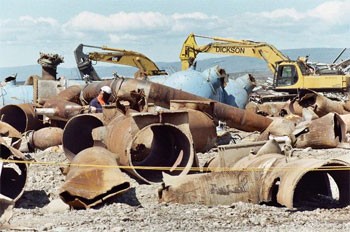By: Duane Craig
Dubbed by the Environmental Protection Agency as "one of the largest and most complex cleanup projects in the U.S.," another part of the Hanford Superfund site in Washington will enter the cleanup process soon. The EPA and the Department of Energy decided on using a combination of techniques for the cleanup because of the variety of ways plutonium has contaminated the soil, according to this news report.
In some soils, the plutonium was mixed with nitric acid, turning it from a relatively soil-stable material into one that migrates through soil more readily. In those places, more soil will be removed. Then, for the remaining areas, the soil will be stored in-situ at a designated, lined landfill at the Hanford site or be sent to the Waste Isolation Pilot Project in New Mexico if it has high levels of plutonium.
This Superfund site sits in southern Washington state, north of Kennewick and east of Yakima. It is right next to the Columbia River, and it is huge. It covers 586 square miles and is divided into four National Priorities List Sites -- 100, 200, 300 and 1100 Areas, according to an EPA fact sheet on the site. This particular cleanup action focuses on four soil waste sites where water and steam contaminated with plutonium 239 were disposed of. Plutonium 239 takes 48,000 years to decay. The area encompasses 10 square miles.
For most of the years between 1943 and 1989, the Hanford site produced plutonium for use in nuclear weapons. At one time, there were six nuclear reactors operating along the river and using its waters to cool their operations. Making plutonium created 43 million cubic yards of radioactive waste, more than 130 million cubic yards of contaminated soil and debris and allowed 475 billion gallons of contaminated water to be dumped on the ground. There are now 80 square miles of contaminated groundwater that have contamination exceeding groundwater protection standards. It poses a risk to the Columbia River and to the people living in Richland, Pasco and Kennewick. Those communities take their drinking water directly from the river. The population of people within 50 miles of Hanford is about half a million.
According to the second five-year review in 2007, the remediation of strontium-90 contamination in the groundwater was not effective, and the strontium-90 along the shoreline was not being reduced by the pump-and-treat system installed there. At the time, the EPA pointed to new work underway that would bring that remediation up to standard and make it protective of health.
Part of the overall remediation of Hanford meant setting up places to store huge amounts of contamination, forever. But the storage plan had to make sure the contaminants would not migrate through soil or into water or air. One such place is called the Environmental Restoration Disposal Facility. From 1996 to 2001, the ERDF received two million tons of nuclear debris, and by 2007, the total was more than seven million tons. It still receives about 3,000 tons of waste every day, according to this EPA document. This disposal area lies between the western and eastern portions of the 200 Area. Hanford is a legendary reminder of World War II and the Cold War, and it shows just how easy it is to create messes that may never really be cleaned up.


No comments:
Post a Comment